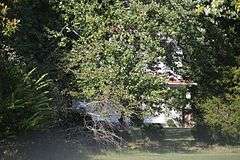Kippax Plantation
|
Kippax Plantation Archeological Site | |
|
Southern portion of the plantation, with the current house visible | |
  | |
| Location | Address Restricted, Hopewell, Virginia |
|---|---|
| Area | 9.3 acres (3.8 ha) |
| NRHP Reference # | 07000799[1] |
| VLR # | 116-5021 |
| Significant dates | |
| Added to NRHP | August 09, 2007 |
| Designated VLR | June 6, 2007[2] |
Coordinates: 37°16′48″N 77°19′05″W / 37.28003519°N 77.3179847°W
Kippax Plantation was located on the south bank of the Appomattox River in what is today the City of Hopewell in southeast Virginia. Kippax Plantation was the home of Colonel Robert Bolling (1646–1709). Bolling married Jane Rolfe, who was the granddaughter of Pocahontas and John Rolfe. Their only child, John Bolling was born at Kippax in 1676, and settled nearby at Cobbs Plantation, just west of Point of Rocks across the Appomattox River in what is now Chesterfield County. While Jane's father Thomas Rolfe (1615–1675) never lived at Kippax Plantation, it is believed that he was buried there, as were Robert and Jane.
Kippax Plantation is considered to be a well-preserved archaeological site that is also well documented. Archaeologist Donald W. Linebaugh, of the University of Kentucky, located the remains of Col. Bolling's house in Hopewell, Virginia in 2002.[3]
Most of the current digging is performed at the site of the unearthed residence. Research by graduate students from the College of William and Mary, headed by Donald W. Linebaugh, have found the remains of at least four separate structures spanning the 17th, 18th, and 19th centuries at the Kippax site. These structures have the potential to answer important research questions regarding the history of early trade between Europeans and Native Americans, the lives of the African American slaves who lived there, and the cultural interaction between these groups.
The Archaeological Conservancy recently purchased the site of Kippax Plantation to protect it from development. Members of the Archaeological Conservancy are in the process of raising the $205,000 needed for the purchase.[4]
References
- ↑ National Park Service (2009-03-13). "National Register Information System". National Register of Historic Places. National Park Service.
- ↑ "Virginia Landmarks Register". Virginia Department of Historic Resources. Retrieved 19 March 2013.
- ↑ "UK Archaeologist Locates 17th Century Merchant's House, Plans Excavation With Students". uky.edu. Retrieved 3 August 2015.
- ↑ "The Archaeological Conservancy". Archaeological Conservancy. Retrieved 3 August 2015.



